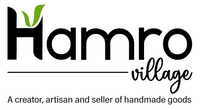Facts About New Zealand & Himalayan Sheep Wool
Felt wool products encompass a variety of items made from wool fibers that are compacted and matted through the application of heat, moisture, and pressure. In Nepal, talented artisans employ traditional hand-felting methods to create products like hats, bags, slippers, rugs, and decorative pieces. This process involves carefully layering the wool and manually agitating it until the fibers bond together, forming a thick and durable fabric.
Corriedale Roving Wool: We use Corriedale wool fibers, sourced from a crossbreed of Merino and Lincoln sheep, an ideal blend for a range of fiber arts. Often referred to as our versatile wool roving, this fiber is perfect for needle felting, wet felting, spinning, and weaving. Whether you're a beginner or an experienced maker, it's a great choice for your next project.
Which varieties of wool are typically used to manufacture felt wool products in Nepal?
Himalayan sheep wool from Nepal is highly valued for its natural warmth, softness, and durability. Sourced from sheep raised in the cold, high-altitude regions of the Himalayas, this wool has adapted to harsh climates, making it exceptionally insulating and resilient. It is often hand-processed by local artisans using traditional techniques such as hand-felting and spinning, preserving both the quality of the fiber and cultural craftsmanship.
The wool is typically used to create a variety of products including carpets, felt items, clothing, and accessories. Because it is natural, renewable, and biodegradable, Himalayan sheep wool is also considered an eco-friendly material. Its production supports rural livelihoods in Nepal and plays a key role in the country’s textile and handicraft industries.
In addition to Himalayan wool, Merino wool, imported from Australian Merino sheep is also used, particularly in the creation of high-end or premium felt products. Merino wool is valued for its exceptional softness, elasticity, and ability to retain warmth while remaining lightweight, making it a popular choice for more refined or specialized felt items. By combining traditional craftsmanship with these quality wool types, Nepalese artisans are able to produce a wide range of durable, eco-friendly felt goods.
An Overview of New Zealand’s Sheep Farming and Wool Industry
Sheep Population: The figure of around 25 million sheep is a realistic estimate. Sheep numbers in New Zealand have been declining since the 1980s (when there were over 70 million), but the current population has stabilized around 25 million in recent years.
Farmland: 13.7 million hectares of farmland with about half as grassland is consistent with government and agricultural data.
Wool Production: 136,000 tons of wool annually are close estimates, though annual production can vary slightly year to year. New Zealand remains a major exporter of sheep wool.
Common Breeds: Romney is still the most common breed. Others like Corriedale, Perendale, Coopworth, and Drysdale remain important.
Merino Wool: New Zealand continues to be a world leader in high-quality Merino wool, particularly for performance apparel and luxury textiles.
Sustainability Practices: Eco-friendly farming methods like rotational grazing and regenerative agriculture are increasingly common.
Wool as Renewable & Biodegradable: Wool’s reputation as a sustainable material is growing, with consumer interest in eco-friendly products rising globally.
Lanolin Use: Lanolin continues to be a valuable byproduct in skincare and pharmaceutical industries.
Shearing Culture: Shearing competitions are still an integral part of NZ’s rural culture, including events like the Golden Shears.
Wool, as a natural fiber, is biodegradable and eco-friendly, breaking down in the environment without releasing harmful pollutants. Sheep wool, in particular, provides comfort, sustainability, and versatility, making it an ideal material for various products. By choosing woolen items, we enjoy their warmth and durability while supporting a more sustainable and comfortable world.


